
Sir Edwin Landseer Lutyens was an English architect known for imaginatively adapting traditional architectural styles to the requirements of his era. He designed many English country houses, war memorials and public buildings. In his biography, the writer Christopher Hussey wrote, "In his lifetime (Lutyens) was widely held to be our greatest architect since Wren if not, as many maintained, his superior". The architectural historian Gavin Stamp described him as "surely the greatest British architect of the twentieth century".

Alwar is a city located in India's National Capital Region and the administrative headquarters of Alwar District in the state of Rajasthan. It is located 150 km south of Delhi and 150 km north of Jaipur. At present the district is famous for production of Mustard Crop in the region, manufacturing of Ray Ban eyeglasses, Beer production plants and frozen food industry.
Events in the year 1911 in India.

The Rashtrapati Bhavan is the official residence of the President of India at the western end of Rajpath, Raisina Hill, New Delhi, India. It was formerly known as Viceroy's House and constructed during the zenith of British Empire. Rashtrapati Bhavan may refer to only the 340-room main building that has the president's official residence, including reception halls, guest rooms and offices, also called the mansion; it may also refer to the entire 130-hectare (320-acre) Presidential Estate that additionally includes the presidential gardens, large open spaces, residences of bodyguards and staff, stables, other offices and utilities within its perimeter walls. In terms of area, it is the 2nd largest residence of any head of state in the world after Quirinal Palace in Italy. The other presidential homes are the Rashtrapati Nilayam in Hyderabad, Telangana and The Retreat Building in Shimla, Himachal Pradesh.
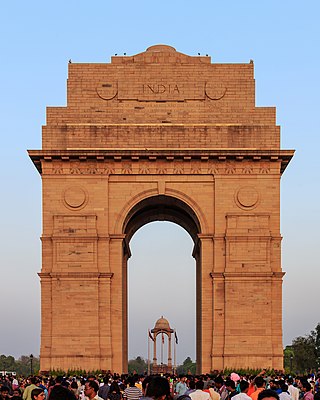
The India Gate is a war memorial located near the Kartavya path on the eastern edge of the "ceremonial axis" of New Delhi, formerly called duty path. It stands as a memorial to 84,000 soldiers of the British Indian Army who died between 1914 and 1921 in the First World War, in France, Flanders, Mesopotamia, Persia, East Africa, Gallipoli and elsewhere in the Near and the Far East, and the Third Anglo-Afghan War. 13,300 servicemen's names, including some soldiers and officers from the United Kingdom, are inscribed on the gate. Designed by Sir Edwin Lutyens, the gate evokes the architectural style of the memorial arch such as the Arch of Constantine, in Rome, and is often compared to the Arc de Triomphe in Paris, and the Gateway of India in Mumbai.

The Delhi Durbar was an Indian imperial-style mass assembly organized by the British at Coronation Park, Delhi, India, to mark the succession of an Emperor or Empress of India. Also known as the Imperial Durbar, it was held three times, in 1877, 1903, and 1911, at the height of the British Empire. The 1911 Durbar was the only one that a sovereign, George V, attended. The term was derived from the common Persian term durbar.

Indira Devi was the Maharani of the princely state of Cooch Behar, British India. She was born a princess of Baroda as the daughter of Maharaja Sayajirao Gaekwad III, by his second wife Chimnabai II.

Loharu is a city, municipal committee and assembly constituency, near Bhiwani City in the Bhiwani district of the Indian state of Haryana. It is the administrative headquarters of one of the four administrative sub-divisions of the district and covers 119 villages. It is also a railway junction station.

Jaigarh Fort is situated on the promontory called the Cheel ka Teela of the Aravalli range; it overlooks the Amer Fort and the Maota Lake, near Amer in Jaipur, Rajasthan, India. The fort was built by Sawai Jai Singh in 1726 to protect the Amer Fort and its palace complex and was named after him.

Samode Palace, Samode Haveli and Samode Bagh (Garden) are heritage monuments and structures built by the noble feudatory with the hereditary title of 'Maha Rawal' or 'Maha Saheb’ of the Amber and Jaipur principality in Rajasthan, India. All three have rich history of several hundred years and display a fusion of Mughal and Rajasthani art and architecture. They are now part of the Heritage group of hotels under the flagship name of "Samode" that are run by the hereditary owners of these structures. The Samode Palace is located 40 kilometres (25 mi) north of Jaipur city, the Samode Haveli is close to Jaipur (centrally located within city limits, 6 kilometres (3.7 mi) away from the city railway station) and the Samode Bagh or Garden, 4 kilometres (2.5 mi) from the palace which is also run as a luxury hotel.
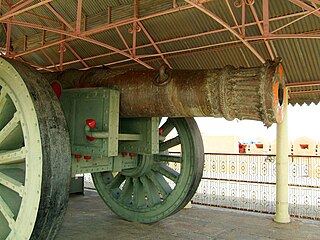
The Jaivana Cannon is a large 18th-century cannon preserved at Jaigarh Fort, in Rajasthan, India. At the time of its manufacture in 1720, it was the world's largest cannon on wheels of the Early Modern Era.

Coronation Park is a park located at Burari Road near Nirankari Sarovar in Delhi, India. It was the venue of the Delhi Durbar of 1877 when Queen Victoria was proclaimed the Empress of India. Later it was used to celebrate the accession of King Edward VII in 1903, and, finally, it was here that the Durbar commemorating the coronation of King George V as Emperor of India took place on 12 December 1911, subsequent to his coronation at Westminster Abbey in June 1911. This last celebration had all the princely states in attendance. The decision to hold the Coronation Durbars in Delhi at the vast open ground at Coronation Park was a move to emphasise the historical significance of Delhi as the former capital of the Mughal Empire.
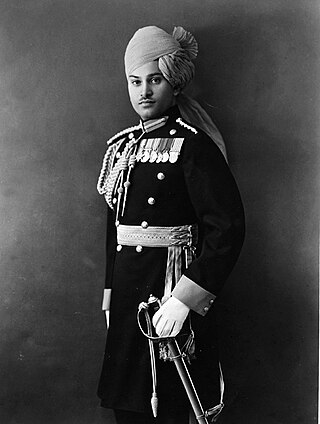
Rao Raja Hanut Singh was a British Indian Army soldier and polo player.
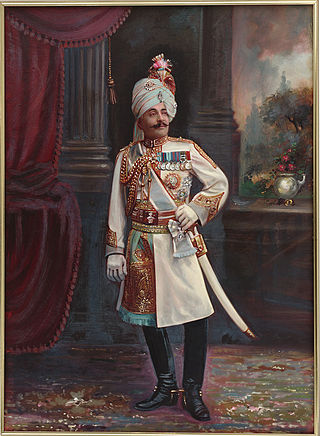
Lieutenant-General Sir Pratap Singh,, was a decorated British Indian Army officer, Maharaja of the princely state of Idar (Gujarat), administrator and Regent of Jodhpur and heir to Ahmednagar later renamed as Himmatnagar from 1902 to 1911.

The City Palace, Jaipur is a royal residence and former administrative headquarters of the rulers of the Jaipur State in Jaipur, Rajasthan. Construction started soon after the establishment of the city of Jaipur under the reign of Maharaja Sawai Jai Singh II, who moved his court to Jaipur from Amber, in 1727. Jaipur remained the capital of the kingdom until 1949—when it became the capital of the present-day Indian state of Rajasthan—with the City Palace functioning as the ceremonial and administrative seat of the Maharaja of Jaipur. The construction of the Palace was completed in 1732 and it was also the location of religious and cultural events, as well as a patron of arts, commerce, and industry. It was constructed according to the rules of vastushastra, combining elements of Mughal and Rajput architectural styles. It now houses the Maharaja Sawai Man Singh II Museum, and continues to be the home of the Jaipur royal family. The royal family has around 500 personal servants. The palace complex has several buildings, various courtyards, galleries, restaurants, and offices of the Museum Trust.The MSMS II Museum Trust is headed by chairperson Rajamata Padmini Devi of Jaipur. Princess Diya Kumari runs the Museum Trust, as its secretary and trustee. She also manages The Palace School and Maharaja Sawai Bhawani Singh School in Jaipur. She founded and runs the Princess Diya Kumari Foundation to empower underprivileged and underemployed women of Rajasthan. She is also an entrepreneur. In 2013, she was elected as Member of the Legislative Assembly of Rajasthan from the constituency of Sawai Madhopur.

Maharaja Sir Sumer Singh was Maharaja of Jodhpur from 20 March 1911 to 3 October 1918, succeeding his father, Maharaja Sardar Singh.

Music in Varanasi is a tradition linked to the ancient times of the Pauranic legends. Lord Shiva, who is reported to have established this city, was credited with developing music and dance forms. Legend also attributes that Renu}, son of sage Vishvamitra and Mahagobind, was the precursors of music tradition in Kashi (Varanasi) when nymphs (Apsaras), Gandharvas and Kinnaras were the traditional practitioners of this art form, and saint Chaitanya and Vallabhacharya were the pioneers in spreading this music tradition in Varanasi. Notable musicians of Varanasi include the iconic sitar player Ravi Shankar, the Shehnai maestro Bismillah Khan, Sarod maestro Vikash Maharaj and singer Girija Devi. has joined the global bandwagon of UNESCO "Cities of Music" under the Creative Cities Network. Varanasi chosen in music category of creative cities network clearly signifies the rich musical heritage of this ancient city.
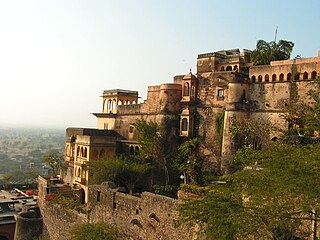
Madhogarh Fort is a fort located on top of Madhogarh Hill in the Aravalli mountain range, near Madhogarh village, in the Mahendragarh district of Haryana state in India. It is located 12 kilometres (7.5 mi) from Mahendragarh, reachable via Satnali Chowk or via Mahendragarh- Satnali- Loharu road.

Maharajadhiraja Sawai Madho Singh II, was the Maharajadhiraja of Jaipur from 1880 until 1922. He was the adopted son of Ram Singh II, Raja of Jaipur.
The Battle of Rajamahal was a military engagement fought in 1747 in Jaipur, India. The battle was fought between the forces of Sawai Maharaja Ishwari Singh and Maharana Jagat Singh, who wanted to make his nephew Madho Singh the Maharaja of Jaipur or secure a Jagir for him, he built an alliance with the Maratha's under Khanderao Holkar and the Hada clan of Bundi and Kota. The battle resulted in a decisive victory for Ishwari Singh's forces.























